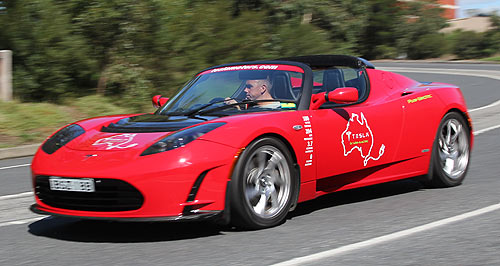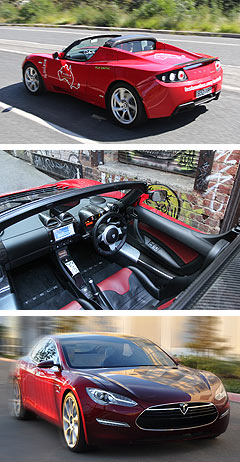Tesla sells more Roadsters in Oz as Model S looms
BY HAITHAM RAZAGUI | 18th Aug 2011

Seven Roadster customers have already taken delivery, with a further four awaiting the build and shipment of theirs, while a further two company cars are also registered – one of which is Tesla Motors Australia national marketing and sales manager Jay McCormack’s daily driver.
Most of Tesla’s Australian customers are among the 53 who have now put their names down for the Silicon Valley-based brand’s next product, the similarly all-electric Model S sports sedan and get to jump the queue once right-hand drive production begins in 2013.
Customers who have reserved their Model S also get an invite to an October 1 event in California in which they will get to experience pre-production Model S cars in action. Mr McCormack said the global order bank was now approaching 6000.
Interestingly, three Roadster owners had not owned a car for between eight and 10 years before taking delivery of their $220,000+ sports EV.
Mr McCormack said those highly environmentally-aware customers “just haven’t wanted to own an internal combustion-engined car”. Before Tesla imported the Roadster to Australia, the only EVs on sale here were aftermarket conversions based on hatchbacks.

Tesla’s local operation is understandably small and without a traditional dealer outlet, for the moment largely consisting of Mr McCormack and a chief technician working from their Sydney base. “Our customers appreciate the personal service,” said Mr McCormack.
As befits a high-tech company based in Silicon Valley, Tesla encourages customers to interact with it (and each other) through an online portal. Even if customers place their order in person or on the phone, they configure their car using Tesla’s ‘design studio’ web application.
“A large amount of the buying experience is online,” said Mr McCormack.
“Whether you are reserving it online or in person, we then introduce you to our online studio, which is an online tool where you can configure your Roadster and send it into the production process. It’s all in real-time and hands-on for the owner.” Australian Roadster customers are represented mainly in New South Wales, with almost all states covered – even Western Australia. “We’re not far off Tasmania,” said Mr McCormack, “which is great for zero emissions because their electricity is hydro.” For customers who do not have access to the NSW service centre, Tesla will fly an engineer out for maintenance duties. Servicing is once per year and can be done in Tesla’s workshop or at the customer’s home or workplace.
Because EVs are far less involved to work on than internal combustion-powered vehicles, servicing tasks mainly comprise safety checks on the brakes and tyres, electronic diagnostics, uploading software updates and the removal any dust build-up in the battery/motor area.
Mr McCormack claims to fly the engineer interstate only costs “about $100 more” than a Sydney pit-stop and that a maintenance routine typically takes about three hours. Software updates and diagnosis can in some cases take place remotely and customers are even able to upload some of their own updates.
Tesla’s published drive-away NSW prices are $222,995 for the Roadster and $260,535 for the slightly quicker Roadster Sport. Both produce an equal 215kW of power but the Sport’s torque output is 400Nm, 30Nm greater than the standard car.
With a Lotus Elise-derived aluminium chassis and unique carbon-fibre skin offsetting the heft of its lithium-ion battery pack, the Roadster weighs in at about 1200kg. The Sport variant can haul itself from rest to 96km/h in 3.7 seconds, two-tenths quicker than its less expensive, less torquey sibling. Top speed is 212km/h for both.
Tesla says just seven per cent of the donor Lotus model is retained, including the chassis, dashboard, fabric hard-top and windscreen.
Mr McCormack said that thanks to the electric motor’s linear power delivery, maximum torque from zero revs and single-speed transmission, a perfect blast away from the lights is as simple as mashing the pedal to the floor, unlike other performance cars in which the driver has to balance revs and clutch or fiddle with launch control settings for a clean getaway.
Depending on how it is driven, Tesla claims the Roadster can achieve a realistic battery range of 394km. Mr McCormack proved this figure to be reliable on an epic all-electric tour from Melbourne to Port Douglas, in which he covered 6187km, consistently achieving a daily range of between 350 and 400km.
His Roadster consumed 1067kWh of electricity on the trip worth $213.40, or just 3.4 cents per kilometre, which is the equivalent cost of driving an internal combustion-powered car that achieves 2.4 litres per 100km (assuming an average fuel price of $1.45 per litre).
Plugging the Roadster into a standard domestic 10-amp socket (not possible with some other EVs such as Mitsubishi’s i-MiEV) requires 15 hours to charge the 56kWh battery pack from empty to full, while an optional $2500 adaptor can connect with standard industrial three-phase power outlets to draw 32 amps and achieve a 6.5 hour charge time.
The fastest option is a 63-amp home-charger that can zap the battery full in just three hours, but costs $3000 plus installation.
Mr McCormack said the Roadster’s battery has a design life of seven years, 160,000 kilometres or 5000 charging cycles and that its lifespan is not diminished by the type of charger used, but can be slightly affected by the charging mode selected.
The three charging modes are linked with the three driving modes selectable from the Roadster’s touch-screen panel. As the name suggests, Range mode optimises the car to extract the maximum distance from the battery (for example reducing torque output by 50Nm) and likewise, ensures the battery is topped up to 100 per cent during charging.
Performance mode unleashes the motor’s full 400Nm for rapid acceleration and also allows the battery to reach 100 per cent charge, while Standard mode charges to 85 per cent.
“If you always charge on standard, you get more (than the quoted 5000) cycles and if you always charged on Performance you might get a few less,” said Mr McCormack.
“There is no time difference in the way you charge, it’s just the way that the energy ends up being stored, whether it’s full capacity, or at 85 per cent capacity.” The Roadster features driver and passenger airbags and a highly sophisticated traction control system that Mr McCormack says “would comfortably go head-to-head with any modern-day electronic stability control”.
However in the eyes of the Victorian government – which made the potentially life-saving technology mandatory from July 1 this year – the Roadster’s lack of ESC is not an issue, due to the number of Roadsters destined to be sold here coming under the 100-unit low volume threshold.